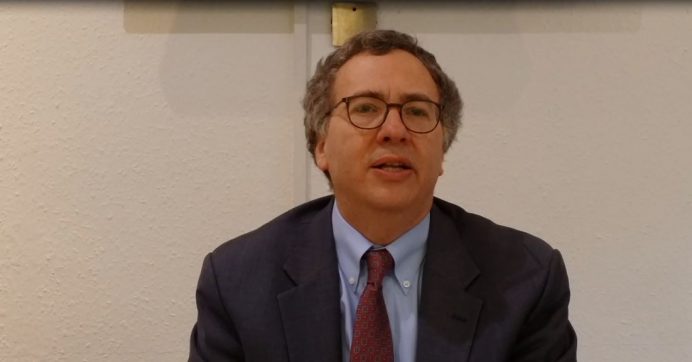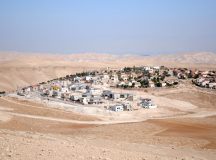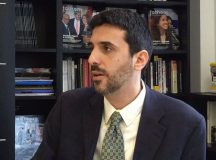Fathom hosted a private briefing with David Makovsky, the Ziegler distinguished fellow at The Washington Institute and director of the Project on the Middle East Peace Process. Makovsky has unique insider perspective on the conflict and possibilities for its resolution, having worked in the Office of the US Secretary of State, serving as a Senior Advisor to the Special Envoy for Israeli-Palestinian Negotiations between 2013-2014. Below is an edited transcript of his remarks.
Sounding an alarm: The ‘Settlement and Solutions’ research project
The ‘Settlements and Solutions’ project is based on an idea. The great American statesmen Daniel Patrick Monahan said it best: ‘Everyone’s entitled to their own opinions, but not their own facts.’ To discuss the two-state solution sensibly today, we need to understand the facts, especially the facts about demography and geography in the West Bank.
The project builds on a Washington Institute study from 2011 called Imagining the Border: Options for Resolving the Israeli-Palestinian Territorial Issue. That project put forward three different territorial scenarios. Our project uses interactive high tech tools to understand exactly where the settlers live and with what impact on the possibility of various territorial outcomes. Our question is: is partition still technically feasible? (We do not ask whether there is a political will to partition – that would require a political analysis of Mahmoud Abbas, Donald Trump, and Benjamin Netanyahu.)
Our conclusion is that a two-state solution is still possible, for now. Only a minority of settlers live in the 92 per cent of the West Bank that is east of the security barrier. That means that 85 per cent (or 76 per cent if you don’t include Jews living in East Jerusalem) live in the 8 per cent of the West Bank that lies between the Green Line and the security barrier.
The good news is that the ratio has held. I’m not saying the barrier is going to be the border, but for analytical purposes, so-called settlement blocs are located in this area between the Green Line and the barrier, and that’s where most the settlers live. That suggests to me that, with land swaps, it’s still feasible to do two states.
The bad news is that while the ratios have held, absolute numbers have increased. There were 70,000 Jews east of the barrier in 2009, and there are now 97,000. Evacuating them would be far from a piece of cake – in the Gaza disengagement, Israel evacuated 8,500 people. There is a tipping point after which an evacuation is not possible, although what that tipping point is, I don’t know. It’s something I worry about.
In a certain way, our project is a warning shot, alerting people of the numbers. I am concerned that the door won’t always remain open, but I do still think that partition is currently doable.
When it comes to peace, there are settlements and settlements. We need to start differentiating.
The project gives an integrated overview of different peace plans and what would happen to the settlements in each plan. We want people to look at the settlement issue not as an absolute, but in relation to the feasibility and impact of different peace plans. If we do that, we can answer the question: ‘Can some settlements be part of a solution rather than part of the problem?’ For example, if there are some places in the West Bank that Abbas has said [in the framework of previous peace negotiations] will be part of Israel, maybe what goes on there isn’t as critical? On the other hand, if there is building in other areas then that is clearly more provocative. We are saying: let’s know which is which.
One of the findings of the project is that the two biggest settlements in the West Bank lie almost on the Green Line and were even due to become part of Israel under the ‘Abbas peace plan’. They are ultra-Orthodox settlements that didn’t exist 20 years ago. 46 per cent of the growth of the entire settlement population from mid-2016 to mid-2017 (out of 139 settlements) has come from these two places alone – Modiin Illit with its population of 69,000 and Beitar Illit, which has a population of 56,000. These two areas have drawn people to them due to the overflow of ultra-Orthodox housing shortages in Jerusalem and Bnei Brak. Our approach – studying the feasibility of partition by looking at the nexus between peace plans and the existing settlement population – also educates the public.
A contrasting example is the settlement of Ariel. There’s been much more public awareness that Ariel is on the verge of being in or out, in a final-status agreement. The public recognition of that has also meant that population figures in the settlement have been flat. People don’t want to move their family to a settlement if its status is unclear. The more the public is aware of where these places are, the more they can make their own determinations. And on the Palestinian side, 82 per cent believe Israel wants all of the West Bank while 58 per cent say that not only does Israel want all of the West Bank but it also seeks to expel every Palestinian. To the extent that settlement building east of the barrier would stop, it would help ease Palestinians’ fears.
Moving away from an ‘All or Nothing’ paradigm
The US internalised a Palestinian critique of the talks of the 1990s – that they were too incremental. So instead, we went big and tried to ‘hit a home run’ by going for a final-status agreement. We have failed three times – Bill Clinton in 2000, Condoleezza Rice in 2007/2008 as part of the Annapolis talks, and the John Kerry-led talks in 2013-2014 (which I was part of). I’m not sure a fourth time would be any different.
The Venn diagram on final status topics doesn’t overlap enough. We have five issues; borders, security arrangements, Jerusalem, refugees, and mutual recognition (i.e. accepting the character of the other sides’ state). As someone who was involved in previous rounds of negotiations, I can tell you that of the five issues both leaders were willing to move on one, but for that movement they wanted the other four. Netanyahu was more flexible on territory and thought that if he could meet the Palestinian criteria on territory then he should get Israeli positions on the other four. Abbas thought that if he were more flexible on refugees then he would get Palestinian positions on the other four. Whenever it’s all or nothing, in the Middle East it’s nothing.
I hope the research project allows us to see that if we can’t do the whole deal at once, we can see more clearly a direction (even if we don’t currently have an agreed destination). I’m not a fan of the settlement enterprise at all and my view is that you can oppose all settlements, but they are there. We have to find where the growth is more acceptable – for example the areas that were part of the Abbas peace plan – and isolate those areas. So, let’s use the data to align settlement policy and two-state policy.
Trump’s Jerusalem announcement
Trump chaffed at the idea of signing the waiver every six months [to postpone moving the embassy] and he’s proud of being able to say that, unlike his predecessors, he fulfilled his campaign promise. I believe that the elements in the administration driving the announcement were not those focused on the peace process, and there is speculation that Jared Kushner and Jason Greenblatt would have preferred to fold this issue into a broader strategy when they present their peace plan in the first quarter of 2018. Rather, I believe it came from other elements of the administration, people who felt that it was important for the president to keep to his campaign pledges.
Trump also feels that even if the Palestinians get 100 per cent of their demands in any peace negotiations, there would still be large chunks of Jerusalem that would be Israel’s capital. Israel has its prime minister, president, parliament and Supreme Court all based in the western part of Jerusalem. The US has been doing business at the prime minister’s office all these years and we have a president – whether Democrat or Republican – who speaks at the Knesset. Despite the fiction that this is not Israel’s capital, we treat it that way, so why not just say the truth and fix the historic anomaly and injustice? That’s the logic to what the president did – it acknowledged reality (although the timing of it can be debated).
And Trump said something else. Unfortunately, it has been glossed over, perhaps because people didn’t see beyond the obvious headline: ‘US recognises Israel capital in Jerusalem.’ Trump said that the borders of the city and sovereignty arrangements would be a result of Israeli-Palestinian negotiations. I’d like to see US government officials go on Arabic media and point this out, because while sometimes the threat of violence is bluster, there are enemies of peace who would love to exploit this situation. We should make it harder for them, and one way is to make clear what Trump said and what he did not say. He did not close the door on anybody’s rights and aspirations, or on negotiations.
Having said that, I would personally have done it differently, by folding the announcement into a broader peace strategy, a package with inducements for both sides.
Q&A
Question 1: The problem with Trump’s speech and with a managed settlement programme is that it represents a big defeat for the Palestinians. And people who are defeated cannot make agreements.
David Makovsky: I don’t see that distinguishing between settlements is a defeat for any side. Yasser Arafat acknowledged in 2000 at Camp David that settlement was a concept the Palestinians accept. Any solution that doesn’t give dignity to both sides by definition isn’t going to work and I am always looking for the win-win. You need people to feel that a solution provides them with greater dignity. I think there will be land swaps. What I would like to see is limitations on Israel settlement activity in a lot of places. Once everything is a ‘5 Alarm Fire’ [a very serious issue], nothing is a ‘5 Alarm Fire’. This way of framing the issue of settlements has to stop.
Question2: The historical peace plans you mentioned go from 2 per cent land swaps from Abbas to just fewer than 6 per cent. The percentage figures you mention are based on an 8 per cent calculation, but that’s more than the best Abbas concession could be. So can it be achieved?
DM: I spoke to Abbas and Saeb Erekat recently and reminded them of the conversation when we discussed the first set of maps, and they said that 1.9 per cent is not in the Quran and 5.8 per cent is not in the Torah, and that’s right.
When I said that I didn’t see the barrier as the border, I meant it. I’m not calling for settlements everywhere inside the barrier. As an analytical tool the barrier is one line you can point toward. I think it will be a mistake to settle in places like Ariel, where it’s controversial. There should be certain areas with more flexibility, but that should be in return for clear restrictions. There needs to be an understanding. In private conversations with Palestinians they have said they can understand and acquiesce to certain things if they don’t have to formally endorse it and if they know that there are restrictions on Israel building in other areas.
Question 3: You’ve talked about land swaps. What do you think of other proposals that are out there, such as each state ending up with minority populations?
DM: In an ideal situation, yes. But I’m not a fan of this idea because the two populations – the settlers in the West Bank and the Arabs in the Galilee – are not symmetrical. The Arabs in the Galilee know they are in Israel, and don’t ask Palestinian Authority (PA) security forces to go into Galilee and protect them, whereas the settlers will want to bring Israel into the West Bank and have the IDF stay and protect them. It would result in leaving behind an ideological minefield. I also don’t think people in Hamas and the PA will accept that. One can debate whether this is advisable. It is safe to say it is a proposition that carries risks.






































Kudos to Makovsky for the excellent work. However, this assumes that the equation for two states is premised on settlements being the crux to be worked with. I humbly suggest that settlements are not, and that the real issue is the word that managed a single gratuitous appearance in the above article: Hamas.
Any attempt at dialog with diplomats on the issue of Hamas is quickly rebuffed or segued into a different topic. Ditto for any attempt at discussing a 3-state solution with Gaza under Hamas, the west bank under Fatah and Israel.
There is a failure by both diplomats and politicians to deal with the reality of having this powerful entity involved in the equation, because Hamas totally rejects the peace process and the two-state solution. Hamas policy has not changed and there is absolutely no indication that Hamas policy will change in the future.
The result is a stalemate in which peace with two-states is simply unattainable. There are no above-board attempts to break the stalemate and no attempts to engage a debate on how to deal with Hamas and two-states.
The result is an educated and aware Israeli public that consistently tells pollsters they support two-states, but then tell the pollsters they do not see it happening at all.
Abbas cannot sign any peace treaty that does not include Gaza, and Gaza cannot be in any peace treaty while Hamas remains in power – yet Hamas will indeed remain solidly in iron-fisted control of Gaza for the foreseeable future.
It’s not the settlements that are pushing any doors closed, it is this affliction of blindness in the impotent diplomatic community that fails to deal openly with the fact that Hamas rejects peace, coupled with the failure of any leader
– Israeli or Arab or other – to emerge who can lead us to some kind of light.
The people still banking on a two-state solution are looking for pie in the sky. As long as the Arabs and all the other Muslim countries can use the Palestinians as a stick with which to beat Israel, there will never be a solution. At present, the only country that yearns for a solution is Israel, it is totally against Arab interests for any solution any time soon.
In reply to : JB Digriz
You directly point an accusing finger at Hamas for the lack of a future peace agreement in the Israel Palestine conflict. Why have you not done so with regard to the Likud Party of Israel?
During the last six months or so there have been debates within the PA and other bodies concerned with finding a solution to the conflict. When it came to the issue of the illegal Israeli settlements there was large suppor for them to remain under the flag of the state of Palestine. In peace negotiations the settlers could be offered the opportuniy to remain and those that didn’t want to could return to where they came from.
This offer will benefit both sides. For example, the Palestinians will benefit economically from the entrepreneurship of Israel projects and in contrast those religiously fervent Jews will fulfill their dreams of “historical return”. Furthermore , this idea could be linked into the legal right of return for the Palestinian refugees. A quid pro quo could be offerd in relation to the number of Jews wishing to remain in Palestine with the number of Palestinian refugees returing to their land, now called Israel.
It will also enhance the opportunity to encourage co-operation among Israelis and Palestinians and this will have further positive aspects regarding security.
PS : Mr Makovsky, have peace negotiations ever started from a legal base regarding the right to the West Bank and East Jerusaelm ? If not, why not? there ever been a peace